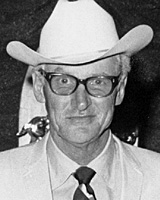 I recently received some mail regarding Tenino Fair, a leading producer of cutting horses and the daughter of a Thoroughbred sire. It reminded me of an article that I wrote about her owner, the late Jay Agnew (photo).
I recently received some mail regarding Tenino Fair, a leading producer of cutting horses and the daughter of a Thoroughbred sire. It reminded me of an article that I wrote about her owner, the late Jay Agnew (photo).
A top non-pro cutting competitor in the 1960s and 1970s, as well as the leading breeder of Thoroughbred racehorses in the Northwest, Agnew believed that cutting pedigrees could be improved by adding the right Thoroughbred bloodlines. As the owner of 1,000 mother cows on his T90 Ranch near Centralia, WA, according to his son Dan, Agnew was able put his theory to the test by introducing his retired racehorses to cow work.
“My father found that there were some Thoroughbreds that had a lot of cow in them,” Agnew said. “He also found out that they were as good or better than a lot of Quarter Horses because they had been bred to race. He could ride Thoroughbreds all day gathering cattle and they wouldn’t even break a sweat.”
Agnew’s greatest success on the racetrack was with Terlago, winner of the San Felipe and Santa Anita Derbies, and beaten favorite with Bill Shoemaker in the 1970 Kentucky Derby. Fairway’s Gal, the dam of Tenino Fair, was a sister to one of Agnew’s stakes winners-turned cow horse.
In addition to Thoroughbreds, Agnew also bred top Quarter Horse runners, including Tiny Lamb and Alamitos Lamb.
In the late 1960s, Agnew purchased Rey Jay’s Pete, an unregistered half-Thoroughbred that Buster Welch had ridden to win the 1966 NCHA Futurity. Agnew placed among the Top 10 NCHA non-pro competitors riding Rey Jay’s Pete in 1969 and 1971; in 1970 and 1971, he won back-to-back NCHA Non-Pro Futurity championships on Rey Lad and Little Boy Rey.
In 1974, Buster Welch won the NCHA World Championship on Mr San Peppy, who he owned in partnership with Agnew. It was Mr San Peppy’s son, Peppy San Badger, who sired NCHA Futurity and Derby champion Little Tenina, out of Tenino Fair.
“Jay was one of the most knowledgeable horsemen that I was ever around,” said Welch. “He loved Thoroughbreds, but he loved cutting horses, too. He always said that the only Thoroughbred that hurts a Quarter Horse is what they don’t have.”
